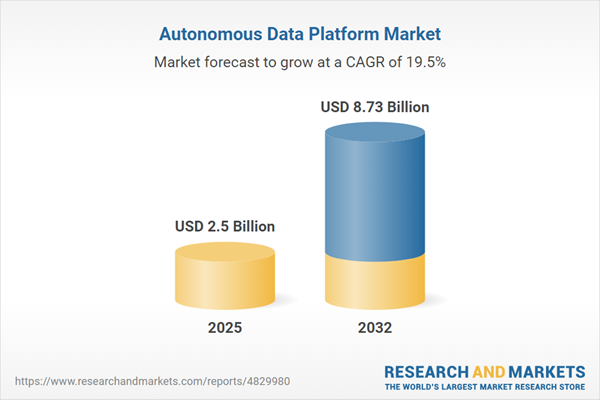Speak directly to the analyst to clarify any post sales queries you may have.
The autonomous data platform market is evolving rapidly as digital transformation accelerates change in how organizations address compliance, security, and governance. Senior executives are seeking solutions that deliver scalable and adaptive capabilities suitable for fluid regulatory and innovation environments.
Market Snapshot: Autonomous Data Platform Market Trends
The autonomous data platform market achieves robust growth, influenced by demand for streamlined automation, advanced analytics, and machine learning integration. Enterprises in regulated sectors such as financial services, healthcare, energy, and manufacturing use these platforms to strengthen data security and ensure regulatory alignment. Modern architectures deliver operational flexibility by coupling intelligent data orchestration with compliance features. As businesses prioritize real-time insights and data-driven strategies, adopting self-optimizing technologies supports organizational agility and maintains effective governance. This balance between innovation and oversight is now central to resilient digital operations.
Scope & Segmentation: Comprehensive Market Coverage
This report provides strategic analysis and segmentation tailored for senior leaders evaluating the autonomous data platform market. Key market domains and stakeholder concerns are addressed in detail:
- Component: Managed services, professional services, analytics software, and governance solutions contribute to workflow efficiency and regulatory support. Integration tools, orchestration technologies, and full-spectrum data management facilitate compliance and operational scalability.
- Organization Size: Solutions are designed to meet the needs of large enterprises, mid-market organizations, and small businesses, taking into account unique risk profiles, scalability requirements, and resource capacities.
- Deployment Model: Cloud, hybrid, and on-premises models deliver flexible, region-specific compliance while accommodating data sovereignty considerations and business continuity objectives.
- Industry Vertical: Relevant sectors include banking, financial services, insurance, energy, utilities, government, defense, healthcare, IT, telecommunications, manufacturing, media, entertainment, and transportation, each requiring customized data integration and governance approaches.
- Regions: Market analysis spans the Americas, Europe, Middle East, Africa, and Asia-Pacific, recognizing varying degrees of digital readiness, local compliance frameworks, and regulatory intensity.
- Key Companies Analyzed: Oracle Corporation, Amazon Web Services Inc., Microsoft Corporation, SAP SE, Google LLC, IBM, Snowflake Inc., Teradata Corporation, MongoDB Inc., and Redis Ltd. shape the competitive landscape through differentiated strategies, partnerships, and technology stacks.
Key Takeaways for Senior Decision-Makers
- Automation, advanced analytics, and machine learning embedded within autonomous data platforms help organizations adapt to dynamic compliance needs while streamlining operational processes.
- Engagement with managed and professional service providers accelerates platform rollouts, minimizes maintenance workloads, and enhances resource productivity within regulated settings.
- Choice of deployment model—cloud, hybrid, or on-premises—enables organizational resilience, maintaining agility amidst fluctuating regional and industry-specific compliance demands.
- Advanced analytics capabilities drive more effective risk identification and improve reporting transparency, vital for organizations operating in tightly governed environments.
- Integrated data management supports cross-departmental transparency, reducing the complexity often associated with digital transformation and easing compliance reporting requirements.
- Organizations in EMEA adopt hybrid solutions to address heightened privacy and data sovereignty concerns, reinforcing the need for localized approaches to infrastructure deployment and compliance.
Tariff Impact: United States Tariffs and Adjusted Supply Chain Strategies for 2025
Recent shifts in United States tariffs motivate B2B technology providers to adapt their supply chains and diversify production strategies. Businesses are increasing adoption of cloud-native and hybrid autonomous data platforms to maintain operational stability amid changing trade regulations. These supply chain changes boost resilience and compliance as global markets and regulatory landscapes evolve.
Methodology & Data Sources
This report uses comprehensive benchmarking, thorough regulatory review, and direct consultation with technology leaders and enterprise data specialists. The methodology ensures a holistic understanding of primary market drivers, industry challenges, and current adoption trends essential for B2B leadership.
Why This Report Matters
- Outlines how autonomous data platform investment supports compliance, governance, and digital transformation initiatives for C-level and compliance leaders.
- Enables risk management and operational flexibility, delivering benchmarking insights for regional and global stakeholders responsible for regulatory adherence and supply chain strategy.
- Aligns IT and compliance investment with shifting governance requirements, equipping organizations to achieve sustained digital growth in complex markets.
Conclusion
Autonomous data platforms give organizations the structure needed to address regulatory, security, and innovation challenges in digital transformation. This report provides actionable guidance for aligning strategic technology investments with compliance and governance frameworks.
Additional Product Information:
- Purchase of this report includes 1 year online access with quarterly updates.
- This report can be updated on request. Please contact our Customer Experience team using the Ask a Question widget on our website.
Table of Contents
3. Executive Summary
4. Market Overview
7. Cumulative Impact of Artificial Intelligence 2025
Companies Mentioned
The companies profiled in this Autonomous Data Platform market report include:- Oracle Corporation
- Amazon Web Services, Inc.
- Microsoft Corporation
- SAP SE
- Google LLC
- International Business Machines Corporation
- Snowflake Inc.
- Teradata Corporation
- MongoDB, Inc.
- Redis Ltd.
Table Information
| Report Attribute | Details |
|---|---|
| No. of Pages | 187 |
| Published | October 2025 |
| Forecast Period | 2025 - 2032 |
| Estimated Market Value ( USD | $ 2.5 Billion |
| Forecasted Market Value ( USD | $ 8.73 Billion |
| Compound Annual Growth Rate | 19.5% |
| Regions Covered | Global |
| No. of Companies Mentioned | 11 |









